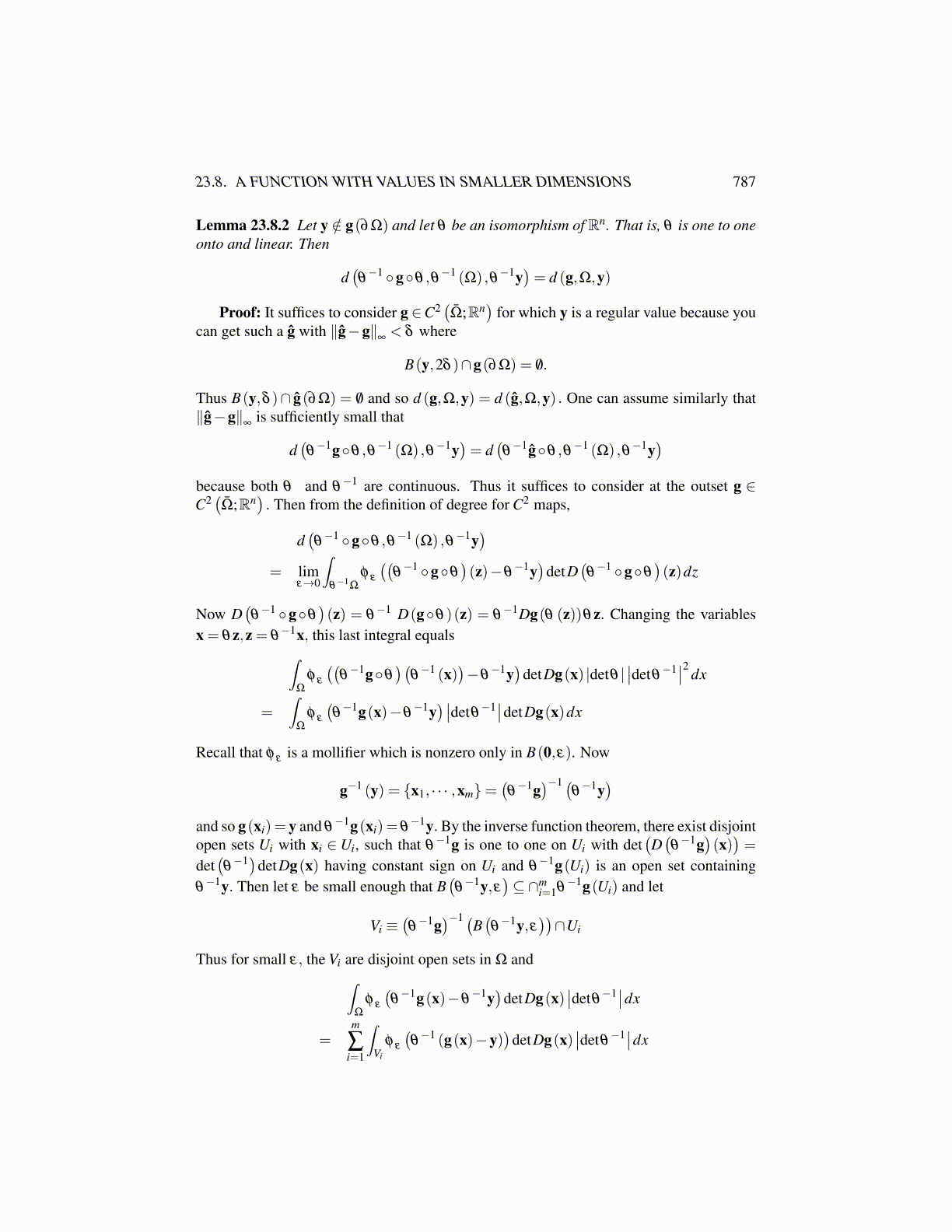
23.8. A FUNCTION WITH VALUES IN SMALLER DIMENSIONS 787
algebra. It is done in [38]. Here we will be a little less ambitious. The following lemmawill be useful when extending the degree to finite dimensional normed linear spaces andfrom there to Banach spaces. It is motivated by the following diagram.
θ−1 (y) θ
−1← y
↑ θ−1 ◦g◦θ ↑ g
θ−1 (Ω)
θ→ Ω
Lemma 23.8.2 Let y /∈ g(∂Ω) and let θ be an isomorphism of Rn. That is, θ is one to oneonto and linear. Then
d(θ−1 ◦g◦θ ,θ−1 (Ω) ,θ−1y
)= d (g,Ω,y)
Proof: It suffices to consider g ∈C2(Ω̄;Rn
)for which y is a regular value because you
can get such a ĝ with ∥ĝ−g∥∞< δ where
B(y,2δ )∩g(∂Ω) = /0.
Thus B(y,δ )∩ ĝ(∂Ω) = /0 and so d (g,Ω,y) = d (ĝ,Ω,y) . One can assume similarly that∥ĝ−g∥
∞is sufficiently small that
d(θ−1g◦θ ,θ−1 (Ω) ,θ−1y
)= d
(θ−1ĝ◦θ ,θ−1 (Ω) ,θ−1y
)because both θ and θ
−1 are continuous. Thus it suffices to consider at the outset g ∈C2(Ω̄;Rn
). Then from the definition of degree for C2 maps,
d(θ−1 ◦g◦θ ,θ−1 (Ω) ,θ−1y
)= lim
ε→0
∫θ−1
Ω
φ ε
((θ−1 ◦g◦θ
)(z)−θ
−1y)
detD(θ−1 ◦g◦θ
)(z)dz
Now D(θ−1 ◦g◦θ
)(z) = θ
−1 D(g◦θ)(z) = θ−1Dg(θ (z))θz. Changing the variables
x = θz,z = θ−1x, this last integral equals∫
Ω
φ ε
((θ−1g◦θ
)(θ−1 (x)
)−θ
−1y)
detDg(x) |detθ |∣∣detθ
−1∣∣2 dx
=∫
Ω
φ ε
(θ−1g(x)−θ
−1y)∣∣detθ
−1∣∣detDg(x)dx
Recall that φ ε is a mollifier which is nonzero only in B(0,ε). Now
g−1 (y) = {x1, · · · ,xm}=(θ−1g)−1 (
θ−1y)
and so g(xi)= y and θ−1g(xi)= θ
−1y. By the inverse function theorem, there exist disjointopen sets Ui with xi ∈Ui, such that θ
−1g is one to one on Ui with det(D(θ−1g)(x))=
det(θ−1)detDg(x) having constant sign on Ui and θ
−1g(Ui) is an open set containingθ−1y. Then let ε be small enough that B
(θ−1y,ε
)⊆ ∩m
i=1θ−1g(Ui) and let
Vi ≡(θ−1g)−1 (
B(θ−1y,ε
))∩Ui